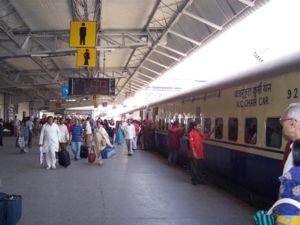Shatabdi Express
Shatabdi Expresses are a series of superfast passenger trains introduced in India in 1988, to serve as connections between Metro and State Capital cities that are relatively close to each other. They are typically operated in such a way that they depart from their respective originating stations early in the morning, reach their destinations by noon or early afternoon, and return with a 30 minute to 1 hour stopover, to arrive back at the originating station by late evening.
Shatabdi and Rajdhani Express are the fastest trains in India. While Shatabdi Express series of trains run over a short distance, Rajdhani Expresses are long-distance trains connecting the National Capital of Delhi to various State Capitals. Both series of trains have a regular speed of 130 km/h. The fastest train in India though is the New Delhi - Bhopal Shatabdi Express which runs at a speed of 150 km/h.
The name "Shatabdi" means centenary in Hindi - the first Shatabdi was introduced in 1988 to commemorate the birth centenary of Jawahar Lal Nehru, the first Prime Minister of India.
Shatabdi Expresses offer fast connectivity with very few stops in between. They are fully air-conditioned and are very luxurious and comfortable to travel in. Indian Railways later introduced a lower-priced version called Jan-Shatabdi Expresses, which were mostly without air-conditioning and had lower fares.
Along with luxury, Shatabdi Express travellers are provided with delicious snacks, breakfast/meals, coffee/tea, One ltr of water can, and a juice. However, over a period of time, many passengers have complained of the deteriorating food quality in the Shatabdi Express trains.
Today, Indian Railways operates 12 pairs of Shatabdi Expresses and 16 pairs of Jan-Shatabdi Expresses. Out of the 12 Shatabdi Expresses, 8 originate from New Delhi (to Bhopal, Lucknow, 2 to Amritsar, 2 to Kalka, Ajmer and Dehradun), two from Chennai (to Bangalore and Mysore) and one each from Kolkata (to Ranchi) and Mumbai (to Ahmedabad).


